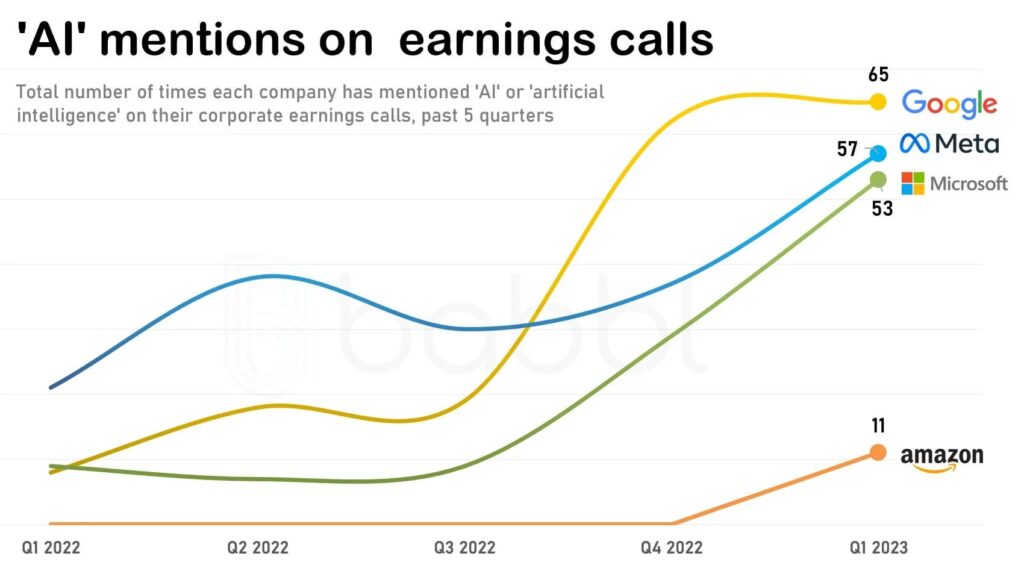Sam Altman, the CEO of OpenAI, which brought us ChatGPT, has gone to Congress to demand regulatory oversight of Artificial Intelligence (AI) technologies. He has long been saying that generative AI, which he helped to develop and propel into our lives, could bring tremendous developmental progress and enormous prosperity to the world. At the same time, if things go wrong, it could also upend human civilization as we know it.
Pick the best stocks and maximize your portfolio:
- Discover top-rated stocks from highly ranked analysts with Analyst Top Stocks!
- Easily identify outperforming stocks and invest smarter with Top Smart Score Stocks
Jim O’Shaughnessy, a legendary Wall Street investor, once said: “Pessimists sound smart – optimists make money.” However, being overly optimistic can lead to devastating losses; it’s much better to base one’s optimism on a realistic approach that includes analysis of the data at hand. So, while we don’t know how to trade the end of the world (and certainly hope we wouldn’t need to), we can try and discern the already astronomic amounts of hype around the technology in order to see whether investors can profit from it.
The Positive Aspects of Bubbles
Most asset bubbles throughout modern history developed around turnaround changes and breakthrough developments, i.e., they were what economists call “productive bubbles” – those that leave society better off after the dust settles. Although the bursting of these bubbles had hurt many people, mostly innocent bystanders who had lost their jobs or life savings, most technological leaps wouldn’t be possible without the massive pools of capital attracted by speculation.
Productive bubbles usually follow similar paths when they inflate:
- There is always a solid thesis at the start, justifying rising prices.
- Word gets around, and everyone is chasing the riches to be made from the new idea.
- The bubble then gets out of hand and it either bursts spectacularly or deflates slowly (depending on many factors, one of the main being the distance between the peak reached on hype and the applicable value of the hyped-up asset).
While financial bubbles were once-in-a-lifetime events in the past, in a modern fast-paced era we seem to develop them every few months. As a result, there’s no need to go as far as the telegraph fever or the electrification boom for examples: in the past three decades, we have watched numerous asset balloons inflating and deflating all around us.
For instance, the technologies of the Dot-Com era changed the world to a massive extent. Still, many of the stocks that crashed in the bursting of that bubble never came back because their valuations were tremendously detached from the real value they could have created.
While green hydrogen presents a sustainable, scalable, and versatile energy carrier that can significantly reduce carbon emissions, hydrogen fuel-cell stocks were inflated like hot-air balloons before falling to earth. Electric vehicles (EVs) also offer substantial sustainability benefits. Still, while we will all eventually be driving electric cars, the bubble that formed around the technology was disconnected from its slow rate of advancement in the real world.
Furthermore, Blockchain technology is also a breakthrough with its ability to provide a decentralized, transparent, secure, and immutable system that enables trustless peer-to-peer transactions and data management. Nevertheless, the humongous Crypto bubble didn’t have a chance since digital currencies are (at least at the moment) quite useless for the overwhelming majority of humans.
Talking Up the AI
This year, with the release of ChatGPT into the world, we have heard the words “Artificial Intelligence” more than during our lifetimes before 2023. The vast hype surrounding generative AI points to a bubble brewing right before our eyes.
While venture funding for startups has almost dried up this year and valuations plummeted, the AI companies live in a parallel universe, still flush with VC money chasing their inflated valuations. Technology companies see markets evaluating their stocks in complete accordance with the number of times their managers say the word “AI” in their speeches; of course, they behave accordingly to satisfy investors, hyping up the technology even more.

The Tech managers are just doing what the markets expect them to do. A bubble is a self-feeding phenomenon; when the hype gets around, those who refuse to participate are punished. Just like in the Dot-Com times, when companies called themselves “internet firms” just because they had a website, now everyone in tech is expected to incorporate AI into their products, or at least mention it in vague terms.
Although it surely feeds the bubble, there is a mutual benefit for all parties. As firms use the term “AI” to hype up their stocks, AI technology benefits from increased investor flows, which are then siphoned into startups actually developing generative AI.
AI Applications Remain Uncertain
Dubbed “the king of ChatGPT,” Sam Altman says that the hype over generative Artificial Intelligence has gotten out of control. He explains that, although ultimately, generative AI will change the world, we are a long way from there. He isn’t alone: while scientists and tech business leaders agree that Artificial Intelligence will bring a major technological shift comparable to the invention of the Internet, no one can lay out a fact-based outlook of the full extent of AI’s implementations. It’s too early for that.
As with any other novel technology, it’s incredibly difficult to foresee its final application at the early stage of development, as it takes time to learn how to implement it best – and that means a long process of trial and error. Just to remind you: when the telephone was invented, it was marketed as a means of broadcasting music to the general public; it took years for the phone to catch on as a communication tool.
Pretenders on the Flanks of the AI Arms Race
The speed with which the generative Artificial Intelligence applications – a theoretical plaything just a couple of years ago – have been entering our lives has been breathtaking. The introduction of ChatGPT has been a pivot moment, made possible by Microsoft’s (MSFT) massive investment in OpenAI. Since then, every self-respecting large tech company has taken part.
According to analysts, generative AI’s addressable market is potentially almost unlimited; UBS (UBS) sees it as “in excess of a trillion dollars.” Goldman Sachs (GS) strategists foresee “the biggest potential long-term support for profit margins” for the S&P 500 (SPX) in the coming years stemming from the AI’s benefits for profitability. With such potential, it is no wonder that large firms go head-to-head for market share.
Microsoft, of course, leads the AI race for now; but Alphabet (GOOGL) is right behind it with its “Bard” chatbot (a ChatGPT competitor) along with other products in the works. Facebook’s parent Meta (META) all but ditched its metaverse dreams in favor of generative AI ambitions, while Amazon (AMZN) said it’s incorporating the technology into its cloud services, platform search, and deliveries.
On the other side of the value chain, there are the suppliers of chips needed to power generative AI capabilities. Nvidia (NVDA) is a huge winner in this space; Bank of America (BAC) has called the company the “leading silicon AI enabler.”
While Big Tech invests heavily and expects to reap the benefits in accordance, there are also many trend-chasers hoping to make a quick buck on the hype. Because generative AI is so new, it isn’t always easy to quickly distinguish between those who can really apply the technology and those who use the buzzword du jour to make an impression on investors.
For example, BuzzFeed’s (BZFD) shares surged by over 300% in just a few days back in January after it said it would utilize AI; the stock crashed 81% since then, burning investors, as the mere mention of AI cannot, of course, make a cash-burner profitable. On the other hand, some previously popular tech companies that feel they were unfairly punished by the markets lately can use the fashionable lingo to attract positive attention; I suspect that that’s what happened with Snowflake’s (SNOW) stock recently.
However, we aren’t in the 90s anymore, and while adding “AI” to the company’s name may create a short-term buzz around it, it won’t help in the long run if the firm doesn’t turn in a profit.

Mining for Digits in the AI Gold Rush
Since ChatGPT is out in the open, collecting millions of fans, the investing world is in the grip of AI FOMO (“Fear Of Missing Out”). Investors are out looking for ways to participate in the AI gold rush besides the obvious options of buying the already-expensive Big Tech stocks.
Some market participants turn to ETFs in search of ways to take part in the AI bonanza. However, as with individual companies’ stocks, having “AI” in the title doesn’t mean much except for a desire to attract investors looking for AI returns. For instance, the most popular “AI” fund, Global X Robotics & Artificial Intelligence ETF (BOTZ), has little connection with AI apart from holding NVDA. Another popular name, iShares Robotics and Artificial Intelligence Multisector ETF (IRBO), is mostly a collection of large U.S. and global technology stocks.
The problem is that there aren’t many generative AI-specific companies in the public domain because the technology is so new. Numerous startups and non-profit tech companies are developing different aspects of technology, like OpenAI, Anthropic, and others, but the financial heavy lifting is done by Big Tech. Developing AI technologies requires a lot of money with little certainty as to when, if at all, it will pay off.
Until these generative AI startups go public in droves, which is not expected in the current market environment, investors can participate in the AI party mostly through the shares of technological giants that are either incorporating AI in their products or supplying the physical means of its development.
At this stage it’s for the better, because the applications of generative AI are still uncertain, and there will be many losers along the way and a limited number of winners. A lot of money will be wasted, and some will bear humongous fruit. Big Tech has the spare cash to take these chances.
In the future, as generative AI’s reach becomes more and more widespread, there will be additional niches and even whole industries built upon its effects on society, from firms optimizing computing resources for AI usage to those dedicated to AI detection in texts, images, and video. In the future – maybe the very near future – there will be numerous investible stocks of companies actually working in the Artificial Intelligence space, not just throwing around AI-lingo.
Meanwhile, I recommend investors looking for AI exposure to copy the billionaires like David Tepper, Stanley Druckenmiller, Bill Ackman, Chase Coleman, and others who are betting on the “old and boring” Alphabet, Microsoft, Amazon, Nvidia, and Meta. Long-term, less valuation-sensitive investors could throw in a few other Tech giants, like IBM (IBM), developing AI platforms to assist healthcare, or SAP AG (SAP), which has collaborated with Microsoft on AI implementation.
For the riskier types of investors, there are stocks of companies that could benefit from incorporating the technology into their products – if they succeed. These include a wide range of still-unprofitable long-time “promising” companies, from Palantir Technologies (PLTR), talking up AI solutions for space exploration, to AI-powered cybersecurity solutions provider SentinelOne (S). However, until a drove of AI developers land on NASDAQ (NDAQ), I would stick with the Big Tech: if the AI craze doesn’t play out, they have other chips to bet.



















